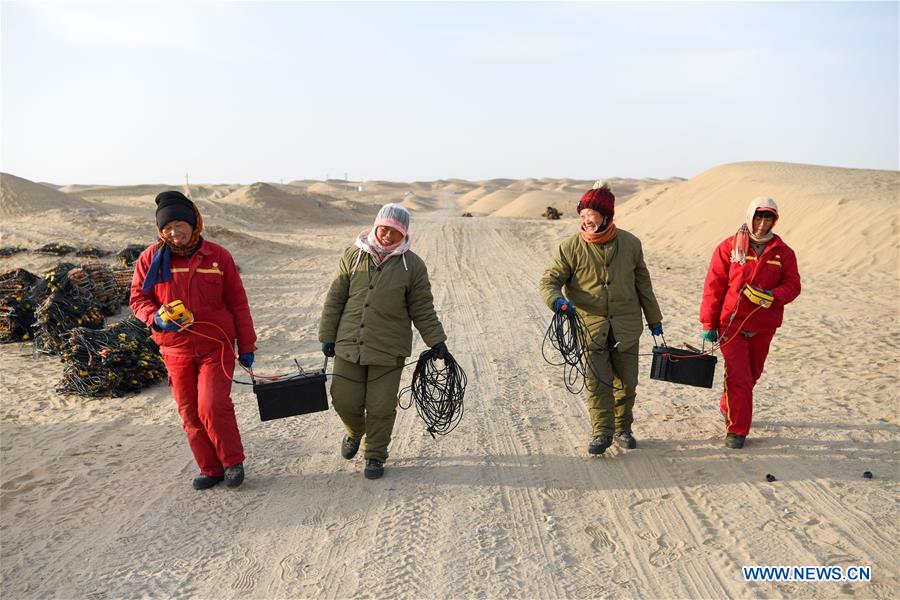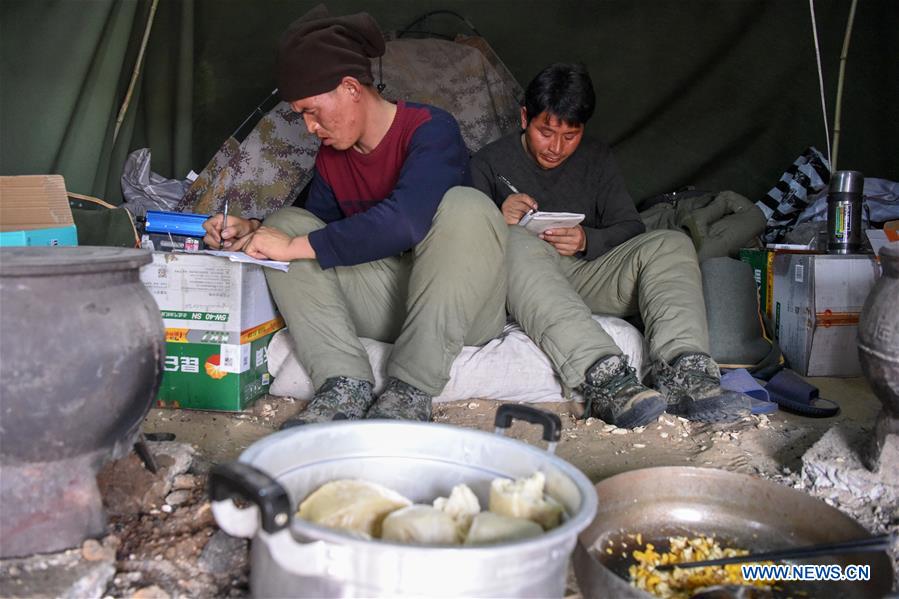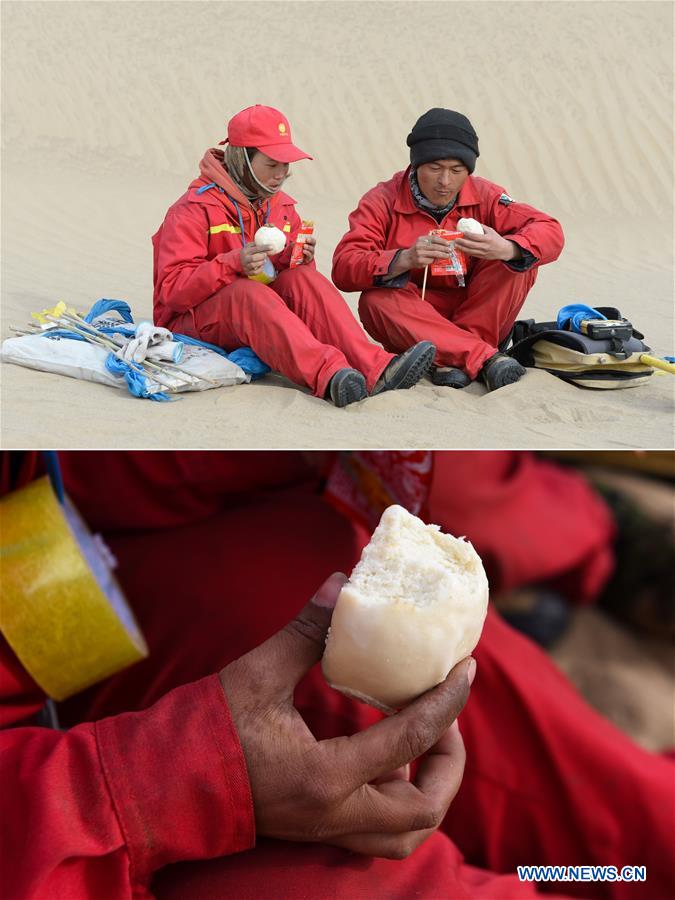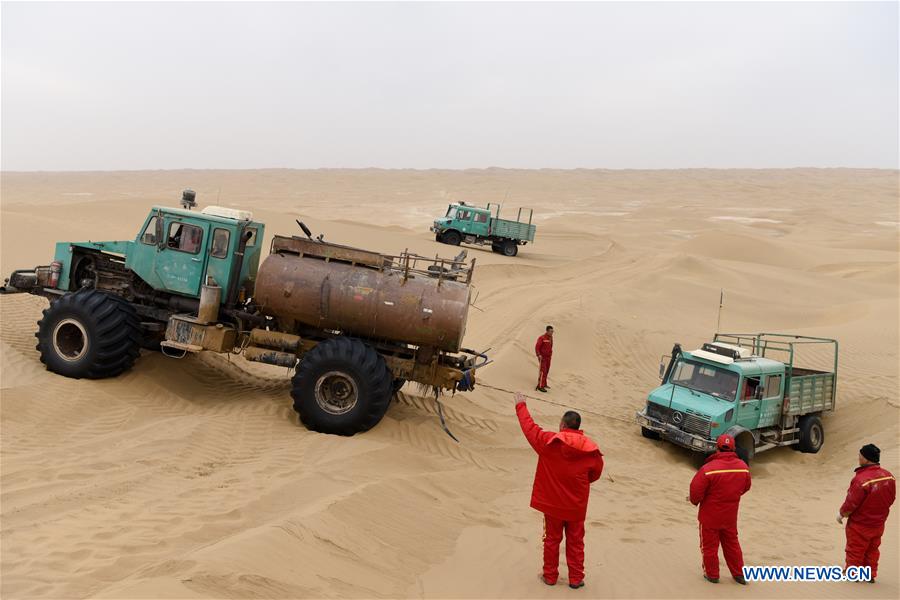
Female workers carry equipment back to camp in the Taklimakan Desert, northwest China's Xinjiang Uygur Autonomous Region, Jan. 14, 2020. Taklimakan Desert, nicknamed "sea of death", is rich in oil and gas resources yet wracked by extremes of heat and cold. To explore the resources requires multiple processes including conducting geophysical survey, so as to collect seismic data to lay a solid foundation for further exploration. To perform the task, workers and researchers have to overcome various challenges and difficulties posed by nature. Every year nearly 2000 workers from BGP Inc., China National Petroleum Corporation (CNPC) start geophysical survey work here in September or October, the most favorable time. This year marks their 14th year to spend Chinese Lunar New Year's Eve in the desert in a row. (Xinhua/Ding Lei)

Combo photo taken on Jan. 13, 2020 shows driller Zheng Fuhong drinking water during a break (top), and frozen water caused by low temperature in the Taklimakan Desert, northwest China's Xinjiang Uygur Autonomous Region. Taklimakan Desert, nicknamed "sea of death", is rich in oil and gas resources yet wracked by extremes of heat and cold. To explore the resources requires multiple processes including conducting geophysical survey, so as to collect seismic data to lay a solid foundation for further exploration. To perform the task, workers and researchers have to overcome various challenges and difficulties posed by nature. Every year nearly 2000 workers from BGP Inc., China National Petroleum Corporation (CNPC) start geophysical survey work here in September or October, the most favorable time. This year marks their 14th year to spend Chinese Lunar New Year's Eve in the desert in a row. (Xinhua/Ding Lei)

Workers build a tent in the Taklimakan Desert, northwest China's Xinjiang Uygur Autonomous Region, Jan. 13, 2020. Taklimakan Desert, nicknamed "sea of death", is rich in oil and gas resources yet wracked by extremes of heat and cold. To explore the resources requires multiple processes including conducting geophysical survey, so as to collect seismic data to lay a solid foundation for further exploration. To perform the task, workers and researchers have to overcome various challenges and difficulties posed by nature. Every year nearly 2000 workers from BGP Inc., China National Petroleum Corporation (CNPC) start geophysical survey work here in September or October, the most favorable time. This year marks their 14th year to spend Chinese Lunar New Year's Eve in the desert in a row. (Xinhua/Ding Lei)

Workers put equipment in vehicles before work in the Taklimakan Desert, northwest China's Xinjiang Uygur Autonomous Region, Jan. 14, 2020. Taklimakan Desert, nicknamed "sea of death", is rich in oil and gas resources yet wracked by extremes of heat and cold. To explore the resources requires multiple processes including conducting geophysical survey, so as to collect seismic data to lay a solid foundation for further exploration. To perform the task, workers and researchers have to overcome various challenges and difficulties posed by nature. Every year nearly 2000 workers from BGP Inc., China National Petroleum Corporation (CNPC) start geophysical survey work here in September or October, the most favorable time. This year marks their 14th year to spend Chinese Lunar New Year's Eve in the desert in a row. (Xinhua/Ding Lei)

Workers record key information from the radio while having lunch in the Taklimakan Desert, northwest China's Xinjiang Uygur Autonomous Region, Jan. 14, 2020. Taklimakan Desert, nicknamed "sea of death", is rich in oil and gas resources yet wracked by extremes of heat and cold. To explore the resources requires multiple processes including conducting geophysical survey, so as to collect seismic data to lay a solid foundation for further exploration. To perform the task, workers and researchers have to overcome various challenges and difficulties posed by nature. Every year nearly 2000 workers from BGP Inc., China National Petroleum Corporation (CNPC) start geophysical survey work here in September or October, the most favorable time. This year marks their 14th year to spend Chinese Lunar New Year's Eve in the desert in a row. (Xinhua/Ding Lei)

Chen Liyun puts cables at a working site in the Taklimakan Desert, northwest China's Xinjiang Uygur Autonomous Region, Jan. 14, 2020. Taklimakan Desert, nicknamed "sea of death", is rich in oil and gas resources yet wracked by extremes of heat and cold. To explore the resources requires multiple processes including conducting geophysical survey, so as to collect seismic data to lay a solid foundation for further exploration. To perform the task, workers and researchers have to overcome various challenges and difficulties posed by nature. Every year nearly 2000 workers from BGP Inc., China National Petroleum Corporation (CNPC) start geophysical survey work here in September or October, the most favorable time. This year marks their 14th year to spend Chinese Lunar New Year's Eve in the desert in a row. (Xinhua/Ding Lei)

Aerial photo taken on Jan. 13, 2020 shows measuring engineers walking in the Taklimakan Desert, northwest China's Xinjiang Uygur Autonomous Region. Taklimakan Desert, nicknamed "sea of death", is rich in oil and gas resources yet wracked by extremes of heat and cold. To explore the resources requires multiple processes including conducting geophysical survey, so as to collect seismic data to lay a solid foundation for further exploration. To perform the task, workers and researchers have to overcome various challenges and difficulties posed by nature. Every year nearly 2000 workers from BGP Inc., China National Petroleum Corporation (CNPC) start geophysical survey work here in September or October, the most favorable time. This year marks their 14th year to spend Chinese Lunar New Year's Eve in the desert in a row. (Xinhua/Ding Lei)

Combo photo taken on Jan. 13, 2020 shows measuring engineers Zhou Guoyan (L) and her husband having lunch (top); and Zhou Guoyan having a cold steamed bun in the Taklimakan Desert, northwest China's Xinjiang Uygur Autonomous Region. Taklimakan Desert, nicknamed "sea of death", is rich in oil and gas resources yet wracked by extremes of heat and cold. To explore the resources requires multiple processes including conducting geophysical survey, so as to collect seismic data to lay a solid foundation for further exploration. To perform the task, workers and researchers have to overcome various challenges and difficulties posed by nature. Every year nearly 2000 workers from BGP Inc., China National Petroleum Corporation (CNPC) start geophysical survey work here in September or October, the most favorable time. This year marks their 14th year to spend Chinese Lunar New Year's Eve in the desert in a row. (Xinhua/Ding Lei)

Measuring engineers work in the Taklimakan Desert, northwest China's Xinjiang Uygur Autonomous Region, Jan. 13, 2020. Taklimakan Desert, nicknamed "sea of death", is rich in oil and gas resources yet wracked by extremes of heat and cold. To explore the resources requires multiple processes including conducting geophysical survey, so as to collect seismic data to lay a solid foundation for further exploration. To perform the task, workers and researchers have to overcome various challenges and difficulties posed by nature. Every year nearly 2000 workers from BGP Inc., China National Petroleum Corporation (CNPC) start geophysical survey work here in September or October, the most favorable time. This year marks their 14th year to spend Chinese Lunar New Year's Eve in the desert in a row. (Xinhua/Ding Lei)

Measuring engineers walk in the Taklimakan Desert, northwest China's Xinjiang Uygur Autonomous Region, Jan. 13, 2020. They walk a minimum of 16 kilometers per day. Taklimakan Desert, nicknamed "sea of death", is rich in oil and gas resources yet wracked by extremes of heat and cold. To explore the resources requires multiple processes including conducting geophysical survey, so as to collect seismic data to lay a solid foundation for further exploration. To perform the task, workers and researchers have to overcome various challenges and difficulties posed by nature. Every year nearly 2000 workers from BGP Inc., China National Petroleum Corporation (CNPC) start geophysical survey work here in September or October, the most favorable time. This year marks their 14th year to spend Chinese Lunar New Year's Eve in the desert in a row. (Xinhua/Ding Lei)

Drillers work at a drilling site in the Taklimakan Desert, northwest China's Xinjiang Uygur Autonomous Region, Jan. 13, 2020. Taklimakan Desert, nicknamed "sea of death", is rich in oil and gas resources yet wracked by extremes of heat and cold. To explore the resources requires multiple processes including conducting geophysical survey, so as to collect seismic data to lay a solid foundation for further exploration. To perform the task, workers and researchers have to overcome various challenges and difficulties posed by nature. Every year nearly 2000 workers from BGP Inc., China National Petroleum Corporation (CNPC) start geophysical survey work here in September or October, the most favorable time. This year marks their 14th year to spend Chinese Lunar New Year's Eve in the desert in a row. (Xinhua/Ding Lei)

A water-tank truck helps a vehicle out of a sandpit in the Taklimakan Desert, northwest China's Xinjiang Uygur Autonomous Region, Jan. 13, 2020. Taklimakan Desert, nicknamed "sea of death", is rich in oil and gas resources yet wracked by extremes of heat and cold. To explore the resources requires multiple processes including conducting geophysical survey, so as to collect seismic data to lay a solid foundation for further exploration. To perform the task, workers and researchers have to overcome various challenges and difficulties posed by nature. Every year nearly 2000 workers from BGP Inc., China National Petroleum Corporation (CNPC) start geophysical survey work here in September or October, the most favorable time. This year marks their 14th year to spend Chinese Lunar New Year's Eve in the desert in a row. (Xinhua/Ding Lei)

Driller Wang Jiwu carries equipment to a working site in the Taklimakan Desert, northwest China's Xinjiang Uygur Autonomous Region, Jan. 13, 2020. Taklimakan Desert, nicknamed "sea of death", is rich in oil and gas resources yet wracked by extremes of heat and cold. To explore the resources requires multiple processes including conducting geophysical survey, so as to collect seismic data to lay a solid foundation for further exploration. To perform the task, workers and researchers have to overcome various challenges and difficulties posed by nature. Every year nearly 2000 workers from BGP Inc., China National Petroleum Corporation (CNPC) start geophysical survey work here in September or October, the most favorable time. This year marks their 14th year to spend Chinese Lunar New Year's Eve in the desert in a row. (Xinhua/Ding Lei)
